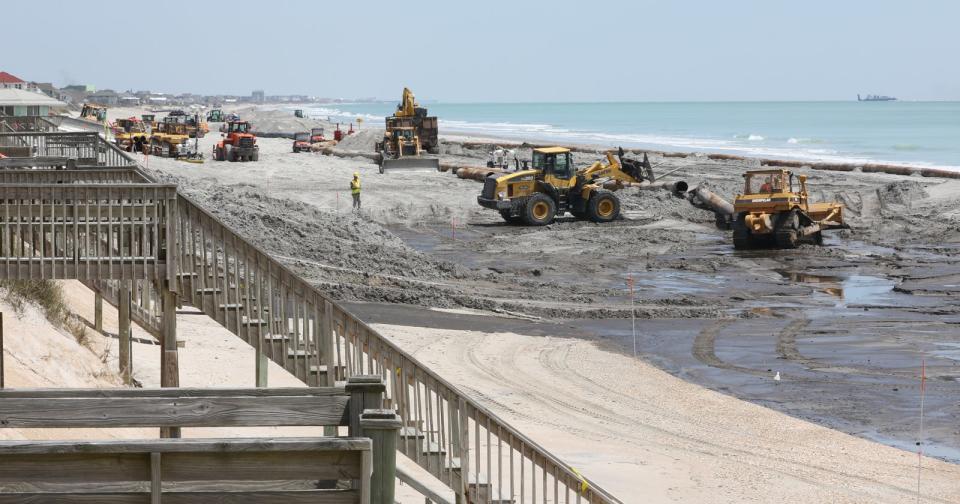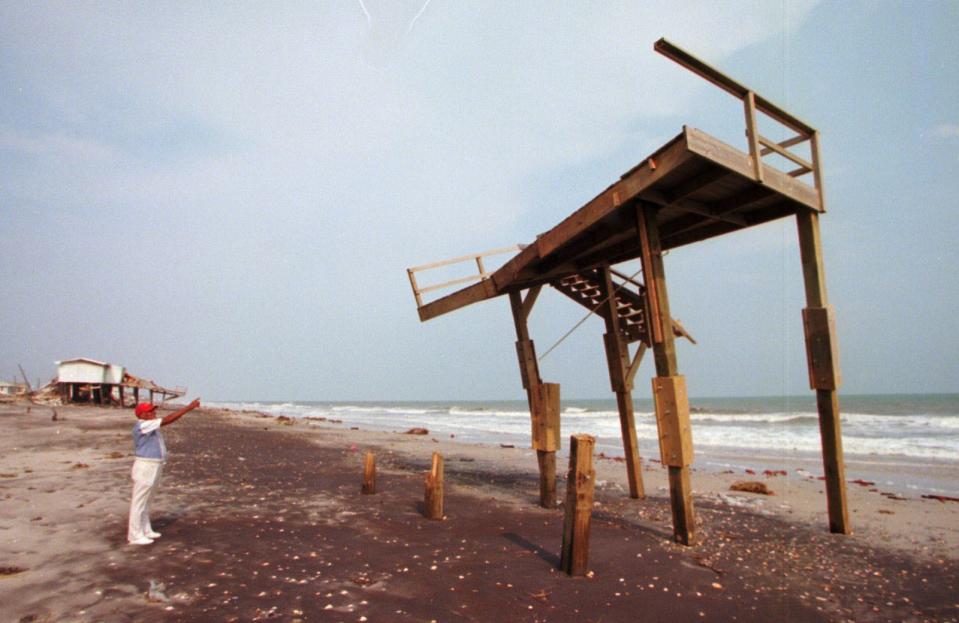North Topsail is getting millions for beach nourishment. How long will the sand last?
Last month North Carolina doled out nearly $20 million in grants to help coastal communities better fortify and rebuild beach infrastructure battered by recent hurricanes, tropical storms, and nor'easters.
"Coastal communities are facing more severe impacts from storms and flooding that require a greater investment in a resilient coastline," Gov. Roy Cooper said in announcing the awards. "Working with local governments to invest in smart storm damage repairs will help combat the effects of climate change and ensure that North Carolina's coast remains a beautiful place to live, work, and visit."
But in a world where climate change is bringing higher seas and more frequent and ferocious storms to our shores, is investing taxpayer dollars in the sand that's all but guaranteed to have a limited lifespan on the beach a smart investment?
STORM STRIKE: Remembering Hurricane Fran at 25 in Photos

That depends. But with other solutions neither easy, politically palatable, or economically realistic − at least not yet, it's often the only option officials feel they have.
But Dr. Robert Young, director of the Program for the Study of Developed Shorelines at Western Carolina University, said it's often just kicking the proverbial can down the road and not thinking about long-term solutions to problems that are only going to get more pronounced and expensive to mitigate in coming years.
"If you can find a way to pay for it, it means a beach community can maintain the status quo, at least for a few more years," he said. "But how viable is that?"
'Very exciting news'
A community along the N.C. coast that probably best sums up this Gordian knot facing officials is North Topsail Beach. The Onslow County community received $10.5 million of the $20.1 million awarded from the state's Coastal Storm Damage Mitigation Fund.
"This is very exciting news for North Topsail Beach because it's going to allow us to extend the (beach nourishment) project for another 2.5 miles, something that we wouldn't have been able to do," said Town Manager Alice Derian
North Topsail occupies the northern half of Topsail Island, and is the recreational heartbeat of the county that's best known as the home of Camp Lejeune.
Learning from Hurricane Ian:Why we should prepare for more storms like it
But North Topsail Beach isn't your typical Carolina beach town. More than half of the town’s 11 miles of beach and a large chunk of its homes are within areas covered by the federal Coastal Barrier Resources Act, or CBRA. The legislation was passed by the federal government in the early 1980s as a way to limit development in areas deemed biologically sensitive or at high risk of damage by hurricanes by making them ineligible to receive federal funding for infrastructure or beach projects. In many other beach towns, the federal government provides the lion's share of a nourishment project's cost, including in New Hanover County's three beach towns and Ocean Isle Beach in Brunswick County.
"Because of the high expense of dune and beach projects, this prevents the town from properly maintaining the beach," states North Topsail's webpage in describing how the CBRA designation impacts the town.
Property owners within a CBRA zone also cannot participate in the National Flood Insurance Program or apply for a VA loan.
Beach erosion has been a major problem for North Topsail Beach for decades, with areas close to New River Inlet at the island's northern end especially hard hit. The string of strong hurricanes that hit the Cape Fear region in the 1990s − Bertha, Fran, Bonnie, and Floyd − decimated the town's dune lines, and flat topography and continued strikes by tropical storms and strong nor'easters in the following years hasn't helped.
The ban on using federal funds for beach projects along much of North Topsail's oceanfront has left local, county, and sometimes state taxpayers often struggling to fund beach projects in areas outside of those areas. In late August, Surf City − the Pender County town that occupies the middle third of Topsail Island − announced it was making progress on its federal nourishment project after North Topsail Beach decided to drop out of the previous joint project over funding concerns.
Issues with its beach, however, haven't stopped North Topsail from riding the boom in coastal real estate in recent years as the town continues to lure vacationers, retirees, and second-home owners. According to the North Carolina Regional MLS, the median home selling price in September was $430,666, up nearly 20% from September 2021. North Topsail's full-time population also has jumped from 740 in 2010 to nearly 1,100 today.

North Topsail is also an economic engine for the surrounding area. According to the state tourism board, Onslow County's tourism spending totaled more than $338 million in 2021, 37% more than in the pandemic-hit 2020. That visitor spending supported nearly 2,100 jobs and generated $27 million in state and local taxes − enough to save Onslow's residents $131 in taxes, according to the report.
"We don't have a commercial tax base here, so we depend on tourism, the second-home real estate market and beach rentals for most of our revenue, which makes having a decent beachside area vital for us," Derian said.
WARMING WORRIES:West Nile virus cases could set a NC record in 2022. Is it tied to climate change?
But Young said there are other ways to protect a beach, such as removing the manmade structures − homes, roads, utilities, and the like − that stop barrier islands from following their natural inclination to wax and wane as determined by the wind and waves.
"We're not doing this to protect the beach," he said of most nourishment projects. "We're doing this to protect those who live on the beach."
Best bang for the taxpayers' buck?
According to the state's storm mitigation grant program, each project was awarded a "score" based on several criteria, including environmental and restoration benefits, economic impact, and lifespan of the project.
Kevin Hart, the program's grant coordinator with N.C. Division of Water Resources said the scoring of each project − including the North Topsail nourishment award − couldn't be released until contracts are executed.
Besides North Topsail, the other grant awards were:
Pine Knoll Shores sand fencing: $90,400
Topsail Beach dune planting: $109,100
Nags Head dune planting: $300,000
Oak Island beach management plan $965,000
North Dare County multi-town beach nourishment $1 million
Beach nourishment to protect N.C. 12, Buxton: $1.5 million
Avon village beach nourishment: $5.5 million
The state grants require matching funds, with Derian stating that North Topsail plans to use funds from the Federal Emergency Management Agency (FEMA) and money from the town's beach nourishment fund for its local match. Final details about the timing and funding for the project are expected to be worked out by the town's board of aldermen in the coming days, she added.
According to the North Topsail website, the upcoming 2.5-mile nourishment project calls for 465,000 cubic yards of truck-hauled sand in "Phase 4" of the town's beach, starting in the 3600 block of Island Drive and working its way north.
"Notice of award has been made and a contract with the state is pending," the town's website states. "In the meantime, permitting for this project is underway."
Hart said funding for the storm-damage mitigation fund is not reoccurring, meaning the General Assembly would have to include additional funding for the program in future budgets. Along with the grant awards, legislators also included $20 million in the recent budget to assist Oak Island in recovering from beach damage sustained from Hurricane Isaias in 2020.
"The amount of money we're spending on beach nourishment is going through the roof," said Young, ticking off the litany of projects planned or underway along the N.C. coast. "I just hope with that amount of money the state is considering the viability of the projects it's supporting and that the taxpayers are getting the best bang for their buck."
Reporter Gareth McGrath can be reached at GMcGrath@Gannett.com or @GarethMcGrathSN on Twitter. This story was produced with financial support from 1Earth Fund and the Prentice Foundation. The USA TODAY Network maintains full editorial control of the work.
This article originally appeared on Wilmington StarNews: North Topsail gets $10M grant for beach nourishment project

